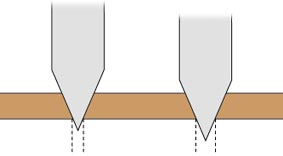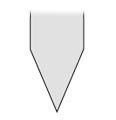About the minimum width of milling
Let us explain how to process and how to use the tools when processing the thin width track and pattern. In case that you process on the substrate thicker than 0.2mm.
You will use the 90 degree or 60 degree end mills. The relationship between the track width and the tools are as following.

This illustrate shows you that the difficulty of keeping the same width of the thin track because of the slight fluctuation of the end mill’s depth.
| 90 degree end mill — | Suitable for processing on the track thicker than 0.2mm. |
| 60 degree end mill — | Suitable for processing 0.2mm steadily, and for challenging 0.15mm. |
When milling the track as thin as 0.1mm, 0.05mm(50µm)
When processing the 0.1mm, 0.05mm (50µm), we recommend using the stub end type end mills impervious to the slight change of the end mill’s depth.
|
Stub end type
|
Pointed end type
|
 |
 |
However, the stub end type end mills are so thin and fragile that we need to employ the stepping method for processing.
As the milling line gets thinner, processing condition becomes ever more crucial. When the diameter of milling bit becomes lower than 100µm, the milling bits become very fragile, leading to increase burrs. Therefore, in processing the milling bit thinner than 100µm, we employ the “stepping method” that process the PCB gradually, which is suitable for the small radial milling bit.
In using the copper foil of 18µm thickness, we mill the board gradually by several steps. (The depth of single milling is 5µm) With this method, you can process the PCB without burrs or breakage even if you use the small radial milling bit.
[videojs mp4=”https://pcbprototyping.com/wp-content/uploads/2015/09/spindle_stepping_480.mp4″]
Difficulty in processing the 0.1mm milling track by ATC machine
As I stated above, for milling 0.1mm wide track, it is imperative to calibrate the depth of end mills very delicately. Especially, by the processing using the end mills whose tip is angular, the depth of the several micron order difference influences the track width. This delicate calibration procedure has to be done manually. Therefore, it is very difficult to calibrate the protrusion of the end mills automatically in order to mill the 0.1mm wide track.